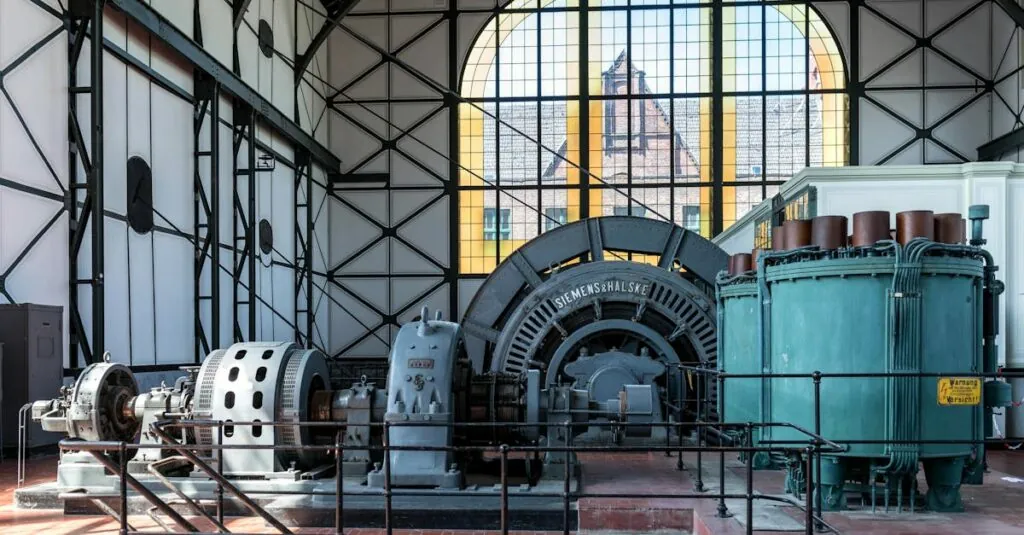Table of Contents
ToggleIn a world where everything from toasters to tractors is getting smarter, the mining industry is finally catching up. Imagine a mine where trucks drive themselves, sensors detect equipment failures before they happen, and data flows smoother than a well-oiled machine. That’s the magic of the Internet of Things (IoT) in mining. It’s not just about digging deeper; it’s about digging smarter.
As the industry faces challenges like safety risks and environmental concerns, IoT offers a lifeline. With real-time data and automation, mines can operate more efficiently and responsibly. So, if you think mining is all about pickaxes and hard hats, think again! The future of mining is here, and it’s more high-tech than ever. Get ready to explore how IoT is revolutionizing this age-old industry and why it’s time to embrace the digital pickaxe.
Overview of IoT in Mining Industry
The Internet of Things (IoT) revolutionizes the mining industry by implementing connected devices and data analytics. Enhanced operational efficiency results from real-time monitoring and automation, allowing miners to track equipment performance and optimize processes. Furthermore, IoT technologies significantly reduce operational costs and improve safety measures.
Sensors collect data from equipment, advancing predictive maintenance techniques. These techniques help identify potential failures before they occur, thus minimizing downtime and repair expenses. Autonomous vehicles and drones streamline operations, enabling remote monitoring and inspection in hazardous environments.
Data management plays a crucial role in IoT applications. Integrated systems gather data from various sources, allowing for better decision-making and resource allocation. Analytics platforms transform raw data into actionable insights, providing a clearer understanding of operational dynamics.
The adoption of IoT in mining also addresses environmental concerns. Smart solutions help track emissions and improve resource utilization, leading to more sustainable practices. Remote sensing and automation reduce the carbon footprint associated with traditional mining methods.
Collaboration between technology providers and mining companies drives innovation. Partnering experts develops tailored solutions that meet specific operational challenges. This collaboration fosters an environment where digital transformation thrives, allowing the mining sector to adapt to an evolving landscape.
As the mining industry embraces these digital innovations, it opens avenues for increased productivity and safety. IoT stands at the forefront of this transformation, showcasing its potential to redefine mining operations for the future.
Benefits of IoT Implementation
IoT technology offers significant advantages for the mining industry, transforming operations and making them safer and more efficient.
Increased Operational Efficiency
Incorporating IoT solutions streamlines operations. Real-time monitoring of equipment enables swift responses to issues, reducing downtime. Predictive maintenance through advanced sensors minimizes unexpected failures, leading to cost savings. Data analytics optimizes resource allocation by providing insights into operational workflows. Automation in processes supports faster production cycles and reduces human error. Machines equipped with IoT devices communicate seamlessly, allowing for coordinated efforts on-site. Enhanced data collection accelerates decision-making, driving improvements in productivity.
Enhanced Safety Measures
Safety in mining benefits immensely from IoT implementation. Wearable devices track worker health metrics, alerting supervisors to hazardous conditions. Environment sensors identify potential dangers, such as gas leaks or equipment malfunctions, warning personnel before incidents occur. Remote monitoring tools allow experts to oversee operations from secure locations, minimizing risk exposure. Autonomous vehicles reduce the need for human operators in high-risk areas, ensuring safer transportation of materials. The integration of IoT technologies promotes a culture of safety by fostering proactive measures and efficient responses to emergencies. Enhanced safety protocols lead to fewer accidents and a more secure work environment.
Challenges in Adopting IoT
Several challenges hinder the adoption of IoT in the mining industry, including infrastructure limitations and data security concerns.
Infrastructure Limitations
Infrastructure limitations pose significant difficulties for IoT implementation. Many mining operations rely on outdated equipment that lacks compatibility with modern IoT devices. In remote areas, connectivity issues make it tough to establish a reliable network for real-time data transmission. Consequently, these constraints prevent efficient data collection and analysis. Mining companies may face high costs to upgrade infrastructure, which can deter investment in IoT technologies. Addressing these limitations requires substantial capital and strategic planning to ensure a seamless integration.
Data Security Concerns
Data security concerns represent another critical challenge of IoT adoption. With increased connectivity, mining operations are more vulnerable to cyberattacks targeting sensitive information and critical systems. Protecting intellectual property and operational data becomes paramount as hackers seek to exploit weaknesses in a network. Mining companies must implement robust security protocols and continuous monitoring systems to safeguard information. In addition, employee training on cybersecurity best practices is essential for reducing risks. Strengthening data security measures ensures that the benefits of IoT can be realized without compromising operational integrity.
Case Studies of IoT Applications
IoT applications in the mining industry showcase innovative solutions that enhance operational efficiency and safety. Companies are leveraging these technologies to address specific challenges and achieve remarkable results.
Smart Equipment Monitoring
Smart equipment monitoring utilizes IoT sensors to track the performance of mining machinery in real time. Real-time data collection enables immediate insights into equipment conditions, allowing operators to make informed decisions about usage. For instance, sensors can monitor the temperature and vibration of heavy machinery. This continuous oversight reduces the likelihood of unexpected failures. Mining companies report improved uptime, as real-time alerts signal maintenance needs before significant breakdowns occur. Enhanced visibility leads to optimized operations and better resource allocation, ensuring machines operate at peak performance.
Predictive Maintenance Solutions
Predictive maintenance solutions rely on IoT analytics to forecast equipment failures. By analyzing data collected from various sensors, organizations predict when maintenance is necessary, ultimately reducing downtime and repair costs. This proactive approach allows teams to perform maintenance during non-peak hours, minimizing disruption. In one case, a mining company implemented predictive analytics that reduced maintenance costs by 20%. Incorporating these solutions leads to higher efficiency and extends the lifespan of critical equipment. Empowered by actionable insights, mining companies can prioritize repairs effectively, driving substantial cost savings and productivity gains.
Future Trends in IoT for Mining
Emerging technologies are set to reshape the mining industry through IoT. One notable trend involves enhanced autonomous systems, leading to increased utilization of unmanned vehicles for transport and monitoring tasks. Such vehicles reduce human exposure to dangerous environments while optimizing operational efficiency.
Advancements in artificial intelligence will complement IoT by providing sophisticated data analytics. Predictive algorithms can analyze data from interconnected devices to foresee equipment failures, thus minimizing downtime. Implementing these AI systems enhances maintenance strategies by shifting from reactive to preventative approaches.
Integrating blockchain technology addresses data security concerns prevalent in IoT. This decentralized approach offers transparent and secure transaction records, protecting sensitive operational data from potential cyberattacks. As data integrity becomes paramount, many mining companies are exploring blockchain implementation as a supplemental measure.
Wearable technology will also see expanded usage within the industry. Instruments such as smart helmets and health monitoring devices provide real-time data on worker safety and environmental conditions, significantly enhancing safety measures. Incorporating this tech aligns with the industry’s objectives of creating a safer working environment.
Emphasis on sustainability will drive the adoption of IoT in mining operations. Using sensors to monitor greenhouse gas emissions and energy consumption will lead to more environmentally friendly practices. This data can facilitate the implementation of strategies that reduce resource wastage and promote energy efficiency.
Collaborative platforms will foster innovation among mining companies and technology providers. Partnerships could encourage the development of customized IoT solutions tailored to specific operational challenges. Sharing best practices among industry leaders will enhance overall efficiency and drive continuous improvement.
The integration of IoT in the mining industry is reshaping operations and driving significant advancements. By leveraging connected devices and data analytics mining companies can enhance efficiency and safety while minimizing environmental impact.
As technology continues to evolve the potential for smarter mining practices grows. Embracing these innovations not only addresses current challenges but also positions the industry for future success.
With a focus on sustainability and safety IoT is set to play a pivotal role in transforming mining into a more efficient and responsible sector. The journey may come with challenges but the rewards of adopting IoT technologies are undeniable.







